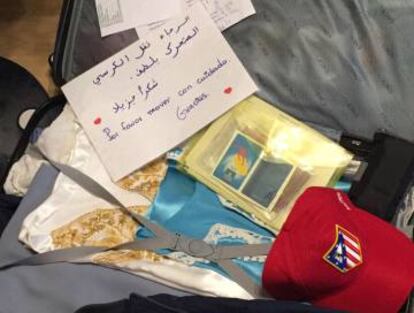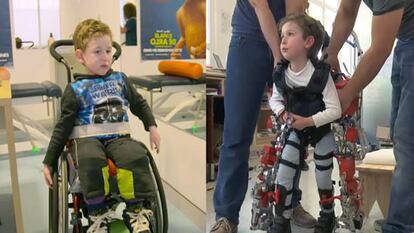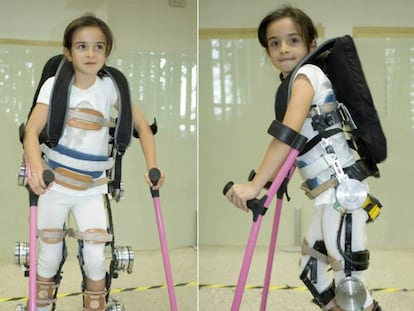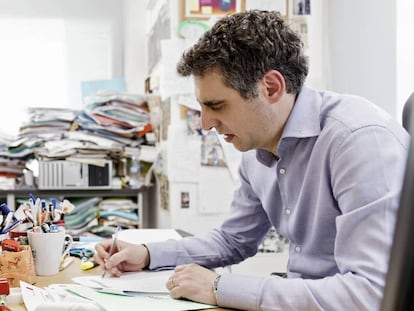Will Álvaro get his exoskeleton and walk?
A revolutionary Spanish invention is helping children with spinal muscular atrophy get back on their feet
Five-year-old Álvaro García didn't know where Dubai was until earlier this month. The only things he knew about this tiny but densely populated city in the United Arab Emirates concerned camels and turbans. On February 15, he flew out from Spain with his parents to the Middle-Eastern desert state to show the world how the exoskeleton for children with spinal muscular atrophy (SMA) works.
The exoskeleton is a Spanish National Research Council (CSIC) invention and was nominated for the UAE AI and Robotics Awards for Good – considered the Oscars of the robotic world. Pitted against eight other candidates in the Most Innovative Design category, the exoskeleton came second, just two points behind a robotic arm for amputees.
“When I tried the exoskeleton, I felt happy,” said Álvaro before leaving, beaming from the wheelchair he has used since he was one. “I want an exoskeleton at home!”
Spinal muscular atrophy is a rare genetic disease affecting one in 10,000 babies in Spain
His dexterity with the chair is awesome, as is his ability to articulate his thoughts and feelings. Álvaro has SMA type 2, which prevents him from standing up, walking and breathing properly. The first time he was asked to try the exoskeleton was two years ago. Since then, he has been called back on various occasions while the design has been developed and perfected with collaboration from both the Ramón y Cajal hospital in Madrid and the San Juan de Dios hospital in Barcelona.
Weighing 12kg and made from aluminum and titanium, it is basically a frame that supports the legs and back – areas where the muscles have been wasted as a result of an attack on the nerve cells in the spinal cord. It was presented to the world last June and could change the lives of the one out of every 10,000 newborns who suffer this rare degenerative disease.
Ten other children with SMA also participated in the clinical trials for the exoskeleton, but Álvaro was the only one who went to Dubai to demonstrate how the device helps him walk. “We’re the only ones mad enough to have volunteered,” said his mother, Ana García, 36, who accompanied him.
Ana and her husband – an office worker and computer engineer – have another son called Miguel who is eight and suffers from Asperger’s Syndrome. “The children’s treatment is the equivalent to a second mortgage,” she said, speaking from a clinic in San Sebastián de los Reyes, Madrid, where Álvaro had his last rehabilitation session before they set off for Dubai.
The exoskeleton is basically a frame that supports the legs and back
The exoskeleton is the brainchild of Elena García, a researcher at CSIC and the founder of Marsi Bionics. This is her second exoskeleton – the first was designed for quadriplegic children. “It’s very exciting to see them walking,” she says. “They are very bright, these children, as you’ve seen with Álvaro, and you can see the delight in their faces.”
García explains that when it comes to projects like hers, there is a lack of government funding to transform research into tangible inventions, and private companies are also loathe to become involved. Marsi Bionics is García’s solution. Through it, she has managed to crowd-fund various projects, including both her exoskeletons. In fact, Álvaro’s exoskeleton was not the only Marsi Bionic invention competing for the award in Dubai, though García says it is the most revolutionary.

Dubai also saw the unveiling of the current version of the exoskeleton for SMA sufferers. After a long process, the device is in line to get its CE distribution certificate and García hopes it will be on the market by the end of the year.
One of the main advantages of the exoskeleton is that it allows SMA children to breathe more easily. Because they are not upright, colds and flu can have far more serious consequences as secretions are hard to shift. “The lungs will have more space,” explains Elena Pinzón, physiotherapist for the DACER Foundation where Álvaro goes for therapy. “They will have more strength to get rid of secretions… It would give the child more postural control and a better quality of life.”
Rehabilitation is crucial for the muscles of children with SMA as it slows down the inevitable wasting process. Álvaro attends therapy three times a week and, according to his mother, his condition has improved considerably on account of it. “When he was diagnosed, they told me I’d better have another child because he was going to die. And now look…”
“If we don’t win the prize, I’m going to find a sheik to finance the exoskeleton,” said Ana ahead of the trip. Meanwhile, Álvaro learned two phrases in Arabic to use when he got to Dubai. "اسمي البارو": "My name is Álvaro" and "اريد ان المشي": "I want to walk".
English version by Heather Galloway.
Tu suscripción se está usando en otro dispositivo
¿Quieres añadir otro usuario a tu suscripción?
Si continúas leyendo en este dispositivo, no se podrá leer en el otro.
FlechaTu suscripción se está usando en otro dispositivo y solo puedes acceder a EL PAÍS desde un dispositivo a la vez.
Si quieres compartir tu cuenta, cambia tu suscripción a la modalidad Premium, así podrás añadir otro usuario. Cada uno accederá con su propia cuenta de email, lo que os permitirá personalizar vuestra experiencia en EL PAÍS.
¿Tienes una suscripción de empresa? Accede aquí para contratar más cuentas.
En el caso de no saber quién está usando tu cuenta, te recomendamos cambiar tu contraseña aquí.
Si decides continuar compartiendo tu cuenta, este mensaje se mostrará en tu dispositivo y en el de la otra persona que está usando tu cuenta de forma indefinida, afectando a tu experiencia de lectura. Puedes consultar aquí los términos y condiciones de la suscripción digital.
More information
Últimas noticias
Trump claims peace in Ukraine is near, but Moscow suggests otherwise
A survivor’s account of the Interoceanic Train accident: ‘We were scared because of the speed on the curve’
The Interoceanic Train, the Mexican alternative to the Panama Canal
What is known about the Interoceanic Train derailment in Oaxaca
Most viewed
- Oona Chaplin: ‘I told James Cameron that I was living in a treehouse and starting a permaculture project with a friend’
- Reinhard Genzel, Nobel laureate in physics: ‘One-minute videos will never give you the truth’
- Why the price of coffee has skyrocketed: from Brazilian plantations to specialty coffee houses
- Pablo Escobar’s hippos: A serious environmental problem, 40 years on
- Chevy Chase, the beloved comedian who was a monster off camera: ‘Not everyone hated him, just the people who’ve worked with him’











































